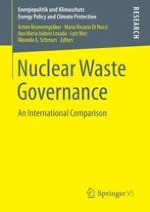This volume examines the national plans that ten Euratom countries plus Switzerland and the United States are developing to address high-level radioactive waste storage and disposal. The chapters, which were written by 23 international experts, outline European and national regulations, technology choices, safety criteria, monitoring systems, compensation schemes, institutional structures, and approaches to public involvement. Key stakeholders, their values and interests are introduced, the responsibilities and authority of different actors considered, decision-making processes are analyzed as well as the factors influencing different national policy choices. The views and expectations of different communities regarding participatory decision making and compensation and the steps that have been or are being taken to promote dialogue and constructive problem-solving are also considered.
